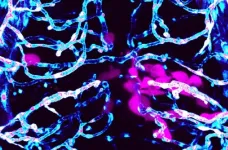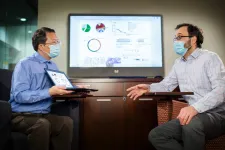Detecting single molecules and diagnosing diseases with a smartphone
2021-02-12
(Press-News.org) Biomarkers play a central role in the diagnosis of disease and assessment of its course. Among the markers now in use are genes, proteins, hormones, lipids and other classes of molecules. Biomarkers can be found in the blood, in cerebrospinal fluid, urine and various types of tissues, but most of them have one thing in common: They occur in extremely low concentrations, and are therefore technically challenging to detect and quantify.
Many detection procedures use molecular probes, such as antibodies or short nucleic-acid sequences, which are designed to bind to specific biomarkers. When a probe recognizes and binds to its target, chemical or physical reactions give rise to fluorescence signals. Such methods work well, provided they are sensitive enough to recognize the relevant biomarker in a high percentage of all patients who carry it in their blood. In addition, before such fluorescence-based tests can be used in practice, the biomarkers themselves or their signals must be amplified. The ultimate goal is to enable medical screening to be carried out directly on patients, without having to send the samples to a distant laboratory for analysis.
Molecular antennas amplify fluorescence signals
Philip Tinnefeld, who holds a Chair in Physical Chemistry at LMU, has developed a strategy for determining levels of biomarkers present in low concentrations. He has succeeded in coupling DNA probes to tiny particles of gold or silver. Pairs of particles ('dimers') act as nano-antennas that amplify the fluorescence signals. The trick works as follows: Interactions between the nanoparticles and incoming light waves intensify the local electromagnetic fields, and this in turn leads to a massive increase in the amplitude of the fluorescence. In this way, bacteria that contain antibiotic resistance genes and even viruses can be specifically detected.
"DNA-based nano-antennas have been studied for the last few years," says Kateryna Trofymchuk, joint first author of the study. "But the fabrication of these nanostructures presents challenges." Philip Tinnefeld's research group has now succeeded in configuring the components of their nano-antennas more precisely, and in positioning the DNA molecules that serve as capture probes at the site of signal amplification. Together, these modifications enable the fluorescence signal to be more effectively amplified. Furthermore, in the minuscule volume involved, which is on the order of zeptoliters (a zeptoliter equals 10-21 of a liter), even more molecules can be captured.
The high degree of positioning control is made possible by DNA nanotechnology, which exploits the structural properties of DNA to guide the assembly of all sorts of nanoscale objects - in extremely large numbers. "In one sample, we can simultaneously produce billions of these nano-antennas, using a procedure that basically consists of pipetting a few solutions together," says Trofymchuk.
Routine diagnostics on the smartphone
"In the future," says Viktorija Glembockyte, also joint first author of the publication, "our technology could be utilized for diagnostic tests even in areas in which access to electricity or laboratory equipment is restricted. We have shown that we can directly detect small fragments of DNA in blood serum, using a portable, smartphone-based microscope that runs on a conventional USB power pack to monitor the assay." Newer smartphones are usually equipped with pretty good cameras. Apart from that, all that's needed is a laser and a lens - two readily available and cheap components. The LMU researchers used this basic recipe to construct their prototypes.
They went on to demonstrate that DNA fragments that are specific for antibiotic resistance genes in bacteria could be detected by this set-up. But the assay could be easily modified to detect a whole range of interesting target types, such as viruses. Tinnefeld is optimistic: "The past year has shown that there is always a need for new and innovative diagnostic methods, and perhaps our technology can one day contribute to the development of an inexpensive and reliable diagnostic test that can be carried out at home."
INFORMATION:
Nature Communications, 2021
ELSE PRESS RELEASES FROM THIS DATE:
2021-02-12
Knowledge on how cells communicate is an important key to understanding many biological systems and diseases. A research team led by researchers at the University of Gothenburg has now used a unique combination of methods to map the mechanism behind cellular communication. Their findings can potentially improve understanding of the underlying mechanism behind type 2 diabetes.
We know that human communication is important, but communication between the cells in our bodies is just as vital. The processes where cells synchronize and coordinate their behaviour is required for an organism to function and for human organs to be able to perform their functions.
"How do cells go from monologues ...
2021-02-12
Scientists at the Fralin Biomedical Research Institute at VTC have identified a new zebrafish model that could help advance glioblastoma multiforme research. Glioblastoma is an aggressive form of primary brain tumor - fewer than one in 20 patients survive five years after diagnosis.
The research team previously discovered that human-derived brain cancer cells in mice use the brain's blood vessels like highways to spread away from the original mass. In the new study, published in ACS Pharmacology and Translational Science, they show clear cross-over between mammals and fish and describe similar observations in zebrafish.
"Our hope is that this new work in zebrafish will help researchers ...
2021-02-12
COLUMBUS, Ohio - On the outskirts of some small Indigenous communities in the Mexican state of Oaxaca, a few volunteer guards keep watch along roads blocked by makeshift barricades of chains, stones and wood.
The invader they are trying to stop is COVID-19.
For many of Mexico's Indigenous people, poor and ignored by state and federal governments, the fight against the COVID-19 pandemic is one that rests primarily with themselves, said Jeffrey Cohen, a professor of anthropology at The Ohio State University.
That means they must take steps like limiting access to their villages.
"Most of these communities only have ...
2021-02-12
peer review/experimental study/animals/cells
Researchers from Uppsala University show in a new study that inhibition of the protein EZH2 can reduce the growth of cancer cells in the blood cancer multiple myeloma. The reduction is caused by changes in the cancer cells' metabolism. These changes can be used as markers to discriminate whether a patient would respond to treatment by EZH2 inhibition. The study has been published in the journal Cell Death & Disease.
Multiple myeloma is a type of blood cancer where immune cells grow in an uncontrolled way in the bone marrow. The disease is very difficult to treat and is still considered incurable, and thus it is urgent to identify new therapeutic targets in the cancer cells.
The research group behind ...
2021-02-12
TROY, N.Y. -- An antioxidant found in green tea may increase levels of p53, a natural anti-cancer protein, known as the "guardian of the genome" for its ability to repair DNA damage or destroy cancerous cells. Published today in Nature Communications, a study of the direct interaction between p53 and the green tea compound, epigallocatechin gallate (EGCG), points to a new target for cancer drug discovery.
"Both p53 and EGCG molecules are extremely interesting. Mutations in p53 are found in over 50% of human cancer, while EGCG is the major anti-oxidant in green tea, a popular beverage worldwide," said END ...
2021-02-12
DURHAM, N.C. -- Humans aren't the only mammals that form long-term bonds with a single, special mate -- some bats, wolves, beavers, foxes and other animals do, too. But new research suggests the brain circuitry that makes love last in some species may not be the same in others.
The study, appearing Feb. 12 in the journal Scientific Reports, compares monogamous and promiscuous species within a closely related group of lemurs, distant primate cousins of humans from the island Madagascar.
Red-bellied lemurs and mongoose lemurs are among the few species in the lemur family tree in which male-female partners stick together year after year, working together to raise their young and defend their territory.
Once bonded, pairs spend much of their waking hours grooming ...
2021-02-12
Every year around 20 Australian children die from the incurable brain tumour, Diffuse Intrinsic Pontine Glioma (DIPG). The average age of diagnosis for DIPG is just seven years. There are no effective treatments, and almost all children die from the disease, usually within one year of diagnosis.
A paper published today 12 Feb 2021 in the prestigious journal, Nature Communications, reveals a potential revolutionary drug combination that - in animal studies and in world first 3D models of the tumour - is "spectacularly effective in eradicating the cancer cells," according to lead researcher and paediatric oncologist Associate Professor David Ziegler, from the Children's Cancer Institute and Sydney Children's Hospital.
In ...
2021-02-12
Children treated for cancer with approaches such as chemotherapy can develop therapy-related myeloid neoplasms (a second type of cancer) with a dismal prognosis. Scientists at St. Jude Children's Research Hospital have characterized the genomic abnormalities of 84 such myeloid neoplasms, with potential implications for early interventions to stop the disease. A paper detailing the work was published today in Nature Communications.
The somatic (cancer) and germline (inherited) genomic alterations that drive therapy-related myeloid neoplasms in children have not been comprehensively ...
2021-02-12
(Friday, February 12, 2021 - Toronto) -- Inhibiting a key enzyme that controls a large network of proteins important in cell division and growth paves the way for a new class of drugs that could stop glioblastoma, a deadly brain cancer, from growing.
Researchers at Princess Margaret Cancer Centre, the Hospital for Sick Children (SickKids) and University of Toronto, showed that chemically inhibiting the enzyme PRMT5 can suppress the growth of glioblastoma cells.
The inhibition of PRMT5 led to cell senescence, similar to what happens to cells during aging when cells lose the ability to divide and grow. Cellular senescence can also be a powerful tumour suppression mechanism, stopping ...
2021-02-12
Space: the final frontier. What's stopping us from exploring it? Well, lots of things, but one of the major issues is space radiation, and the effects it can have on astronaut health during long voyages. A new review in the open-access journal END ...
LAST 30 PRESS RELEASES:
[Press-News.org] Detecting single molecules and diagnosing diseases with a smartphone






